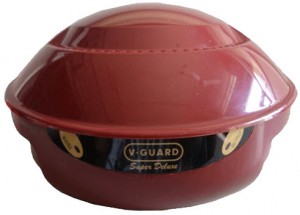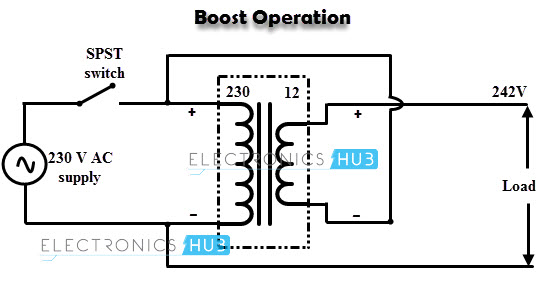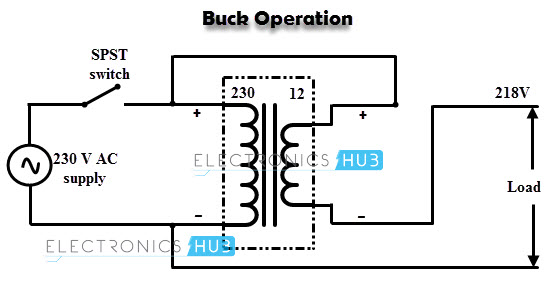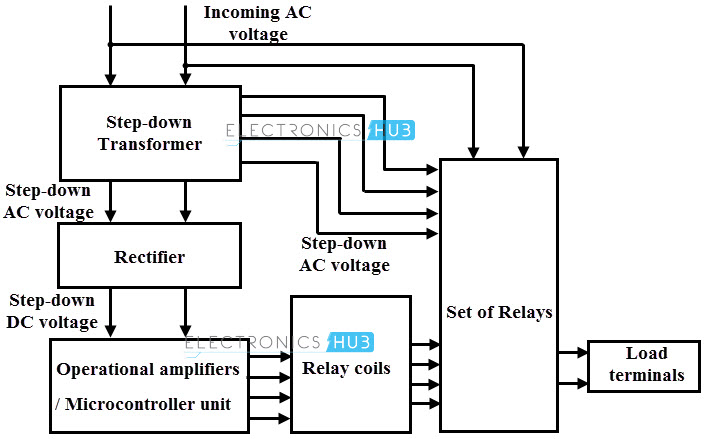This is because each and every electrical appliance is designed to operate under a specific voltage to give desired performance. If this voltage is below or above certain value, the appliance would malfunction or might operate at worse condition or even it might get damaged.
In home and industrial applications, generally automatic voltage regulators are employed to keep the voltage constant to the particular equipment. Let us know more about these voltage stabilizers in detail.
What are Voltage Stabilizers?
As the name suggests, a voltage stabilizer stabilizes or regulates the voltage if the supply voltage varies or fluctuates over a given range. It is an electrical appliance that feeds constant voltage to a load during over and under voltage conditions. This device detects these voltage conditions and correspondingly brings the voltage to desired range. Voltage stabilizers provide a means to regulate the supply voltage to the load. These are not meant to provide a constant voltage output; instead it operates the load or system in an acceptable range of voltage. The internal circuit of a stabilizer is shown in figure below. It consists of auto transformer/ transformer, rectifier unit, comparators, switching circuit and relays.
In case of modern digital type stabilizers, a microcontroller or microprocessor is used as central control unit. There are different types of voltage stabilizers available in today’s market from various manufacturers. Stabilizers come with a different KVA rating for normal range (to produce 200-240V output with 20-35V boost-buck for input range of 180-270V) as well as a wide range (to produce 190-240V output with 50-55V boost-buck for input range of 140-300V) applications. These are available as dedicated stabilizers for various homes as well as industrial appliances such as air conditioners, LCD/LED TV, refrigerators, music systems, washing machines and also available as a single large unit for all appliances. Stabilizers consume very less power, typically about 2 to 5% of maximum load (i.e., rating of stabilizer). These are high efficiency devices, typically 95 to 98%. These can be single phase or three-phase voltage stabilizers. Both non digital and digital automatic voltage stabilizers are available from well recognized manufacturers. Some additional features are available in modern stabilizers that include high voltage protection, overload protection, zero voltage switching, frequency variation protection, voltage cut off display, etc.
Need of Voltage Stabilizers
Voltage fluctuations are nothing but the change in magnitude of voltage, of which normally exceeding or below the steady state voltage range prescribed by some standards. In some countries, electric power distribution is 230 volts for single phase and 415 volts for three-phase. In such case, all electrical appliances (especially, single phase) designed to operate in the voltage range of 220 to 240V. The acceptable range of voltage in some countries (also in India) is 220 ± 10V as per the electricity standards. And also, many appliances can withstand this voltage fluctuation range. But in most places, voltage fluctuations are quite common and typically, they are in the range of 170 to 270V. These voltage fluctuations can be significant in adverse effects on appliances.
In case of lighting equipment, low voltage drop reduces the lumen output (illumination) that will further reduce the life of the lamp. AC motor produces less torque and hence the speed under low voltage, and they produce more speed than desired during overvoltage. This degrades motor life and also causes insulation damage under high voltages. In case of induction heating, low voltage reduces heat output which causes the load to operate at inappropriate temperatures than desired. In TV and radio transmission, voltage drop will reduce the quality of transmission and also cause the malfunction of other electronic components. Refrigerators are AC motor driven appliances that draw large currents during voltage drop conditions which may lead to overheating of windings.
To overcome above mentioned effects of voltage variations, voltage stabilizers are needed.
Basic Principle of Operation of Voltage Stabilizer
The voltage regulation is required for two distinct purposes; over voltage and under voltage conditions. The process of increasing voltage from under voltage condition is called as boost operation, whereas reducing the voltage from overvoltage condition is called as buck operations. These two main operations are essential in each and every voltage stabilizer. As discussed above, the components of voltage stabilizer include a transformer, relays, and electronic circuitry. If the stabilizer senses the voltage drop in incoming voltage, it enables the electromagnetic relay so as to add more voltage from transformer so that the loss of voltage will be compensated. When the incoming voltage is more than normal value, stabilizer activates another electromagnetic relay such that it deducts the voltage to maintain the normal value of voltage.
Boost Operation
The principle of boost operation of a voltage stabilizer is shown in figure below.
Here, the supply voltage is given to a transformer, which is normally a step-down transformer. This transformer is connected in such a way that the secondary output is added to the primary supply voltage. In case of low voltage condition, the electronic circuit in the stabilizer switches corresponding relay such that this added supply (incoming supply + transformer secondary output) is applied to the load.
Buck Operation
The principle of buck operation of a voltage stabilizer is illustrated in figure below.
In buck operation, the secondary of step-down transformer is connected in such a way that secondary output voltage is deducted from incoming voltage. Therefore, in case of incoming voltage rise, the electronic circuit switches the relay that switches deducted supply voltage (i.e., incoming voltage –transformer secondary voltage) to the load circuit. In case of normal voltage operating condition, electronic circuit switches the load entirely to incoming supply without any transformer voltage. These buck, boost and normal operations are same for all stabilizers whether they are normal type or servo mechanism type stabilizers. In addition to these two main operations, voltage stabilizer also performs lower and higher voltage cut off operations.
Working of Voltage Stabilizer
The figure below shows the working model of a voltage stabilizer that contains a step-down transformer (usually provided with taps on secondary), rectifier, operational amplifier/microcontroller unit and set of relays.
In this, op-amps are tuned in such way that they could sense various set voltages such as lower cut off voltage, boost condition voltage, normal operating voltage, higher cut off voltage and buck operating voltage. A set of relays are connected in a manner that they trips the load circuit during higher and lower cut off voltages and also they switch buck and boost voltages to the load circuit. A step-down tap changing transformer has different secondary voltage tapping which are helpful for operating operational amplifier for different voltages and also to add-up and deduct voltages for boost and buck operations respectively. A rectifier circuit converts AC supply into DC to power-up entire electronic control circuit as well as relay coils. Let us assume that this is 1 KVA single phase stabilizer that provides stabilization for voltage range of 200 to 245 with a boost-buck voltage of 20-35 V for input voltage of 180 to 270 V. If the input supply is, say 195 V, then operational amplifier energizes boost relay coil such that 195 + 25 = 220V is supplied to the load. If the input supply is 260 V, corresponding op-amp energizes buck relay coil so that 260-30 = 225 V is supplied to the load. If the input voltage is below 180 V, corresponding op-amp switches lower cut off relay coil such that load is disconnected from the supply. And if the supply is beyond 270 V, corresponding op-amp energizes higher cut off relay coil and hence load is terminated from the supply. All these values are approximate values; it may vary depending on the application. By this way, a stabilizer operates under different voltage conditions.
Servo Controlled Voltage Stabilizers
In case of automatic voltage stabilizers, the speed of voltage correction is very less. The high speed voltage correction at a greater precision is achieved with servo controlled stabilizers. In servo controlled stabilizers, voltage correction is done very precisely, i.e., closer to the base voltage value. The main components of a servo stabilizer include servo motor driven continuously variable auto transformer, buck-boost transformer and solid state control circuit as shown in the figure below. In this stabilizer, solid state control circuit sense voltage fall and rise from a predetermined value and correspondingly operates the servo motor. The primary winding of buck-boost converter is connected to the motorized auto transformer whereas its secondary is connected in series with incoming supply. Whenever motor operates the autotransformer, appropriate voltage is supplied to the primary of the buck-boost transformer and hence corresponding secondary voltage corrects the supply voltage to the load. Here comparators (nothing but op-amps) in solid state control circuit senses the voltage changes and activates servo motor to a desired location so that variable transformer increase or decrease the output voltage to the load. When the control circuit finds output voltage higher than a reference voltage, it feeds the positive signal to the servo motor controller and hence the arm rotates till the two voltages are equal. If the output voltage falls below the reference value, a negative signal goes to the servo motor such that arm rotates the contact in other way so as to reduce the voltage. Servo stabilizers can produce output regulation of ±0.5% with high efficiency about 98%.
How to Select a Suitable Stabilizer for Home Needs?
Voltage stabilizer sizing depends on the rating of equipment to which stabilization is to be employed. So the first and foremost thing while purchasing a voltage stabilizer is considering power of all appliances (or a particular appliance) that will be supplied by stabilizer. Such power ratings are normally quoted in VA or KVA. And also need to consider whether it is single or three phase power. The power rating of the appliances is normally shown on the name plate of that appliance; if power rating is not available simply calculate the product of voltage and current of that equipment to get the power rating. It is always recommended to consider true RMS voltage of the load. Another major factor is, considering future expansion of the load. So determining total power rating requires possible future expansion, typically 20% more than actual power requirement in order to connect loads over the long run. For home needs, 200VA, 300 VA, 500 VA, 1 KVA, 2 KVA, 3 KVA, 4 KVA, 5 KVA, 8 KVA and 10 KVA rated voltage stabilizers are suitable. For industrial and commercial purposes, high power rated servo stabilizers are needed. Word from Electronics Hub Team There is a general saying that modern LED TVs, refrigerators, air conditioners and other appliances have in built stabilization capability and hence they do not need additional voltage stabilizers. However, they cannot boost or buck that much range voltages as separate voltage stabilizers can achieve. So Electronics Hub team always recommends you to have a voltage stabilizer to your home or industrial needs if your electricity has frequent voltage fluctuations. Image Contributors
Voltage Stabilizer : pimg.tradeindia.com Internal Circuit : g02.s.alicdn.com Three Phase Stabilizer : canadian-power.com Need of stabilizer : vguard.in Servo controlled stabilizer: i00.i.aliimg.com
Otherwise, this is a brilliant explanation. Cheers! Comment * Name * Email * Website
Δ













![]()